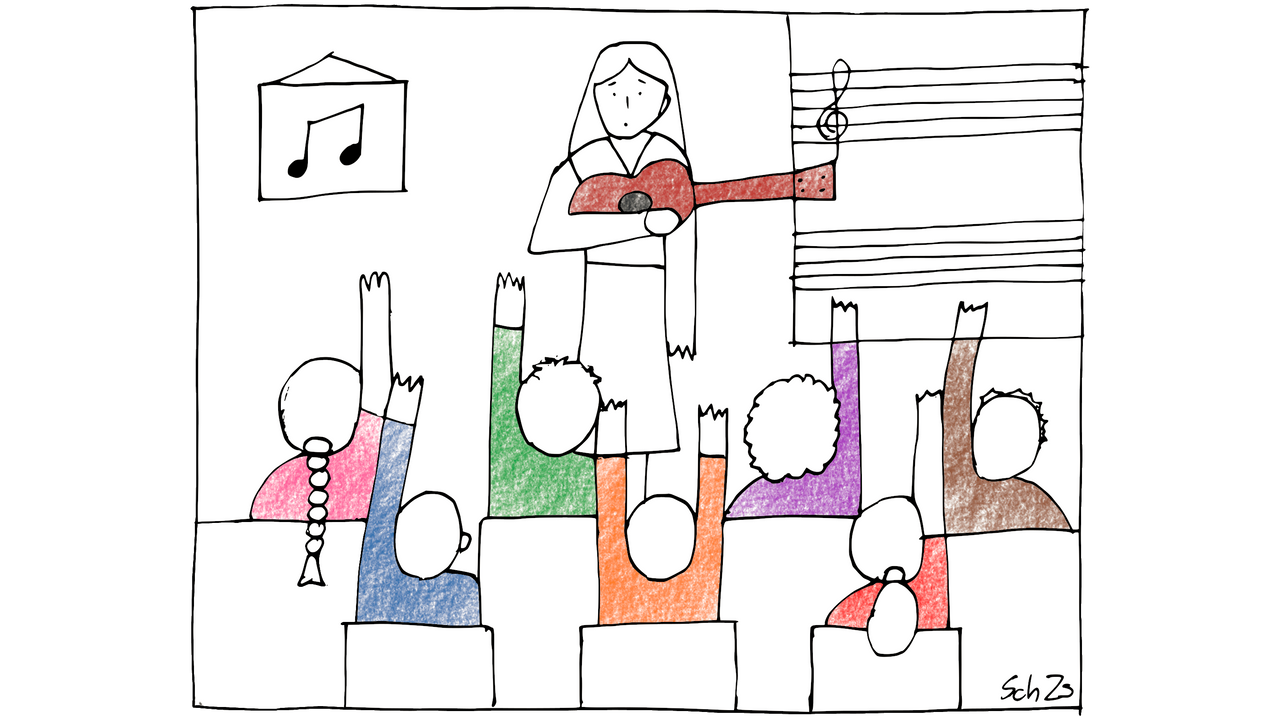Is It OK To Play Ukulele With A Pick? (And Other FAQs)

As ukulele teachers and leaders, we get asked a lot of questions, many of which are common across our classes and groups. This month we’ll offer some ideas for a few frequently asked questions you might hear in your classroom or group.
1. How do you know what strumming pattern to use ukulele?
I’m sure you’ve heard this one about strumming patterns A LOT! We certainly have. There are a number of ways to approach this and much depends on who you’re teaching and how you’re teaching it.
The best place to start is the down-up motion and getting your students used to consistency, perhaps moving between straight and swing (or lilting) feels. From there, you can consider how the patterns get built, which is ultimately adding or taking away strokes or “touches” as you continue to move your strumming hand up and down. While this might take a full blog post to explore, here are a few interesting considerations from James’s podcasts that might be helpful.
James offers some clarification around what constitutes a strum (versus a stroke) here on this Uketropolis podcast at around the 22:00 minute mark.
For an enjoyable exercise to practise strumming while singing, check out the Strumble game. There's a fun, free download too!
2. Is it OK to play ukulele with a pick?
Of course, you can play the ukulele with a pick! While you don’t need a pick (or plectrum) to play ukulele since it has fairly gentle nylon or fluorocarbon strings, there could be times when a pick can make sense.
In the Ukulele in the Classroom method (for groups/classrooms), as well as The Ukulele Way (solo playing), players are encouraged to start by using their thumb for picking. This helps build right hand facility and creates a warm tone, eventually working up to chord-melody playing. In both of these methods, there is a time when flatpicking is introduced as a concept and demonstrates the pick’s ability to generate bright sound and enable quick note-playing and tremolo effects.
Picks can also serve to help players who might have difficulty manipulating their fingers for any number of reasons so it can provide support in strumming and picking. The felt pick can be a good option for those who wish to strum but don’t want the harshness of a flat pick. Strumming using a flatpick (a.k.a. guitar pick) makes for a very loud, bright sound. Of course, some players like to use thumb and finger picks for fingerstyle playing, as well.
All this to say, it depends on the context! But we encourage students to try the thumb and fingers first for that warm, gentle sound.
3. I am left-handed. Can I play the ukulele?
Yes! Anyone can play the ukulele, left-handed or right-handed.
Like most other instruments, we play the ukulele with two hands so it can be good to encourage playing in the same way as a right-handed player to start. There can be many reasons why a young student might be prompted to play “left-handed.” With children at the beginner level, left-hand skills can often be the toughest to master, requiring the honing of fine motor skills. In a way, left-handed students have some advantage with dexterity!
If, however, after some effort of trying to play right-handed and the student is still attempting to play left-handed or inquiring, it may be time to switch the instrument. Note: simply flipping the instrument over will not suffice!
In this case, or if you are working with an older student who clearly identifies as left-handed and wishes to play this way, you’ll need to re-string the instrument so that the chord fingerings remain the same and standard chord diagrams will be mirror images. We strongly suggest that the student buy their own ukulele so that the left-handed instrument doesn’t get mixed into a class set in a school/lending setting.
Pssst... If you're a beginner Ukulele player, then you'll want to check out our Beginner Ukulele Course, or, if you're more of an intermediate level of playing, then you'll want to check out our Booster Uke course!
There are a lot of common questions that arise in our groups and classrooms and, from time to time, we will share a few of the most common here in our Pedagogy Corner posts. You can also find a list of helpful FAQs for teachers (some relate specifically to Ukulele in the Classroom) here: https://ukuleleintheclassroom.com/faq
Let's keep the discussions going with these questions, too! Head over to the Uketropolis Community and share your questions and answers to pressing ukulele questions!
Uketropolis.com is the best resource for learning the ukulele online, with a variety of courses and lessons available, from free lessons to in-depth courses
Stay in the Uke Loop!
Subscribe to the Uketropolis Gazette. Free arrangements, tips, interviews and more delivered to your inbox.


